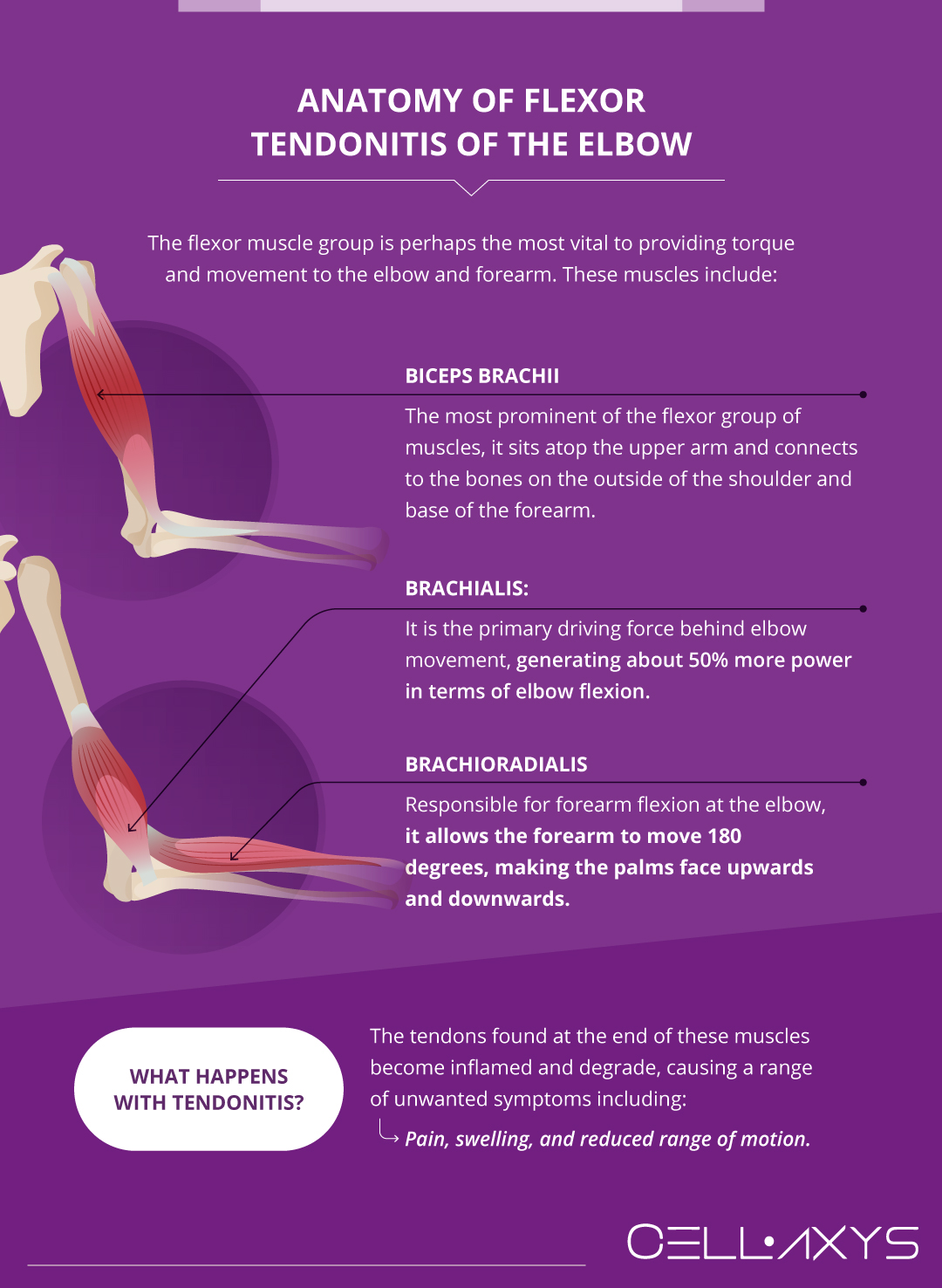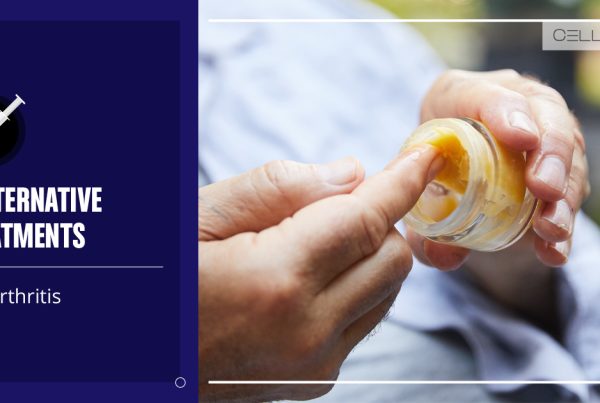Published on: November 18, 2019 | Updated on: August 29, 2024
Flexor tendonitis of the elbow is a common issue that causes major dysfunction of the elbow and its surrounding tissues.
Identifying the impacted tissues, root causes, and major symptoms can help patients understand what is going on and help them decide the best treatment option for their specific lifestyle.
Anatomy of Flexor Tendonitis of the Elbow

The elbow is a focal point for some of the most important soft tissues within the body. Groups of tendons, muscles, and cartilage converge here to create a versatile joint.
From swinging a tennis racket to hurling a baseball, the elbow’s only bounds are determined by the health of the soft tissues within it. While each group of these tissues serves a valuable purpose, the flexor group is perhaps the most vital to providing torque and movement to the elbow and forearm. These muscles include:
- Biceps Brachii: The most prominent of the flexor group of muscles, the biceps brachii sits atop the upper arm and connects to the bones on the outside of the shoulder and base of the forearm.
- Brachialis: While the biceps brachii gathers the most attention and interest from athletes, the brachialis just beneath it is the primary driving force behind elbow movement, generating about 50% more power in terms of elbow flexion.
- Brachioradialis: Responsible for forearm flexion at the elbow, the brachioradialis allows the forearm to move 180 degrees, making the palms face upwards and downwards.
In a case of flexor tendonitis of the elbow, the tendons found at the end of these muscles become inflamed and degrade, causing a range of unwanted symptoms including pain, swelling, and reduced range of motion.
Over time, the health of the tendons degrades until even the slightest movements cause the symptoms to express themselves.
Signs and Symptoms of Flexor Tendonitis of the Elbow
Tendonitis begins as slight pain within the elbow and at the base of the underside of the forearm. This pain progresses slowly as the tendons degrade and may only appear after strenuous use of the elbow.
The pain may express itself as stiffness, throbbing, or mild discomfort as you begin the activity, wane once the elbow is warmed up, and then return as the activity is decreased.
Other symptoms include:
- Swelling
- Reduced range of motion
- Numbness in the elbow or forearm
- Loose hand grip
- Reduced fluidity in elbow movement
- Chronic tension
- Sensitivity to touch or colder temperatures
As the health of the tendons within and around the elbow worsens, the symptoms will become more overt and will express themselves with less activity. In some cases, a person may even lose the ability to move the elbow and forearm in certain ways depending on which tendons are impacted.
Causes of Flexor Tendonitis of the Elbow
Soft tissues are innately weak structures and anything that requires constant or repetitive strain on these structures can leave behind small amounts of damage. If left unchecked or if this damage isn’t allowed to heal properly, the impact on these structures amplifies, and the health of the tendons wanes.
The most common cause of elbow tendonitis is repetitive, strenuous elbow motion. Flexor tendonitis is most often seen in tennis players, golfers, baseball pitchers, and blue-collar workers whose jobs require extended periods of elbow strain.
Other causes of flexor tendonitis include acute damage such as impact from a projectile or falling on the elbow. These types of injuries usually lead to the rapid development of tendonitis as they not only impact the tendons but the bones and other muscles they connect to as well. As the tie between bone and muscle breaks down, symptoms develop into chronic issues.
Diagnosing Flexor Tendonitis of the Elbow
Flexor tendonitis shares symptoms with several elbow issues, so diagnosis is best done through a consultation with a trained physiologist. These doctors will use the patient’s medical history and lifestyle to identify potential causes of their elbow pain and typically move on to a physical examination or the use of medical imaging from there.
Physical examinations for flexor tendonitis are simple. Doctors use a technique known as palpation where they apply pressure to certain areas of the elbow while it is in various states of flexion to pinpoint the origin of a patient’s elbow pain. Once the location is established, medical imaging does the rest.
MRIs, X-rays, and CAT scans can give doctors an inside view of the soft tissues and bones within the elbow. From there they can examine the health of the soft tissue structures and identify points of damage to develop a treatment plan.
Conventional Treatments for Flexor Tendonitis of the Elbow
Conventional treatment options are used to help manage a patient’s pain. While these treatment options may not fully cure a patient’s flexor tendonitis, they can improve the patient’s range of motion, reduce pain, and mitigate the chances of the continued degradation of the soft tissues within the elbow.
The following conventional treatments are some of the most popular methods of controlling the progression of flexor tendonitis and are typically used in unison with one another to improve the quality of the treatment plan.
Physical Therapy
Physical therapies are simply treatment options by physical means. Massage, guided stretching, hot/cold therapy, compression, and exercise are some of the most commonly applied physical therapies for those with flexor tendonitis.
These treatments help patients work within their physical limitations and can provide temporary relief from elbow pain due to tendonitis. While they are not cure-alls, these methods are valuable as they are the most economical and easily applied to most soft tissue problems.
Medication
If the symptoms of flexor tendonitis are still relatively minor, doctors will often recommend simple over-the-counter medications such as naproxen, ibuprofen, and acetaminophen. If the effects of these medications are too mild to treat a patient’s pain, doctors may prescribe larger doses or can move on to stronger medications that block the pain receptors in the brain.
Medication can be a valuable tool to help combat a patient’s elbow pain but should be used sparingly and only within the doctor’s restrictions. Some of these medications have harmful side effects and may even pose a risk of addiction if use isn’t controlled. It is best to talk to your doctor about any concerns you may have moving forward with any medication regimen.
Steroidal Injections
At one point thought to be a miracle cure to soft tissue pains, in recent years steroidal injections have come to be known as a dangerous treatment tactic in the medical community.
While these treatments may provide immediate relief from soft tissue-related pain, over time they have been shown to worsen the health of the soft tissue structures they aim to treat, increasing the severity and presence of symptoms within patients.
Steroidal injections should be met with an err of caution and be heavily researched before being applied.
Surgery
If the conservative treatments mentioned above do not seem to be helping a patient, doctors may recommend surgical intervention for a patient’s flexor tendonitis. This is typically a doctor’s last option as the side effects can be severe and the results minimal.
Surgical intervention typically involves long recovery periods, strong medication, and the use of extensive physical therapy. While this treatment may reduce a patient’s pain, it may also drastically reduce a patient’s range of motion and nullify any functional goals the patient would hope to reach.
Conventional treatment options are the most commonly recommended by doctors, but they may not be the most effective when dealing with flexor tendonitis. While they can help patients reduce their pain, the results are minimal compared to some of the alternative treatment options available today.
Regenerative Therapy for Flexor Tendonitis of the Elbow
Regenerative therapies help reduce pain and repair damaged tissues. The regenerative treatment options include minimally invasive orthobiologic methods that give better results in certain instances of soft tissue damage.
The two most popular orthobiologic therapies are platelet-rich plasma (PRP) and cell-based therapies.
PRP Therapy
Platelet-rich plasma (PRP) therapy extracts platelets from the blood, which are special healing components of our plasma. Platelets are responsible for forming clots after an injury and promoting fast healing.
They release 10 Growth Factors in the blood and send chemical impulses to attract fresh tissues to repair the injury. Platelets also form a sticky, web-like scaffolding called fibrin. Fibrin supports and boosts the growth of healthy tissues and cells.
With a high number of platelets in your elbow, you can heal from flexor tendonitis faster. PRP is usually completed within 45 minutes and is an outpatient procedure, meaning you can go home right after the procedure.
Cell-Based Therapies
Also known as stem cell therapy, cell-based therapies focus on harvesting healthy cells from the adipose (fat) tissue and bone marrow and injecting them into the injury sites. The procedure uses your own “autologous” tissues, so the process is completely safe.
Depending on your elbow injury, you may undergo one of the two types of cell-based therapies:
- Minimally Manipulated Adipose Tissue transplant (MMAT). This cell-based therapy involves extracting blood from your adipose tissue and reinjecting them into your injury sites. The doctor can perform MMAT in multiple locations within the same procedure.
- Bone Marrow Concentrate (BMAC). This procedure harvests healthy and highly concentrated cells from your bone marrow and reinjects them into your elbows.
For both cell-based procedures, the doctor will put you under anesthesia to minimize pain intensity. The doctor will identify the exact transplant location through live X-ray and ultrasound.
Both are completed in about 1.5-2 hours. Like PRP, cell-based therapies are also outpatient procedures, which means you can go home after the procedure.
The added benefit of regenerative therapies over conventional treatment options is that they not only treat the symptoms of flexor tendonitis but can also help treat its causes. Over time, regenerative therapies can return function and range of motion to an elbow suffering from tendonitis.
Sources
Footnotes
- Kraushaar BS, Nirschl RP. Tendinosis of the elbow (tennis elbow): clinical features and findings of histological, immunohistochemical, and electron microscopy studies. Journal of Bone and Joint Surgery. 1999;81(2):259.
- Pitzer ME, Seidenberg PH, Bader DA. Elbow tendinopathy. Medical Clinics. 2014;98(4):833-49.
- Frostick SP, Mohammad M, Ritchie DA. Sport injuries of the elbow. British journal of sports medicine. 1999;33(5):301.
- Taylor SA, Hannafin JA. Evaluation and management of elbow tendinopathy. Sports Health. 2012;4(5):384-93.
- Nirschl RP, Ashman ES. Elbow tendinopathy: tennis elbow. Clinics in sports medicine. 2003;22(4):813-36.
- Mishra A, Pavelko T. Treatment of chronic elbow tendinosis with buffered platelet-rich plasma. The American journal of sports medicine. 2006;34(11):1774-8.
- Pountos I, Panteli M, Walters G, Bush D, Giannoudis PV. Safety of epidural corticosteroid injections. Drugs in R&D. 2016;16:19-34.
References
- Flexor Tendinopathy. SportsCare Canberra. Accessed 2/26/2024.
- 6 Effective Ways to Treat Elbow Tendon and Tendonitis. Jacksonville Orthopaedic Institute. Accessed 2/26/2024.
- Golfers Elbow (Medial Epicondylitis), Flexor Mass Tendon Tear. Riley J. Williams III, M.D. Accessed 2/26/2024.
CELLAXYS does not offer Stem Cell Therapy as a cure for any medical condition. No statements or treatments presented by Cellaxys have been evaluated or approved by the Food and Drug Administration (FDA). This site contains no medical advice. All statements and opinions are provided for educational and informational purposes only.
Dr Pejman Bady
Author
Dr. Pejman Bady began his career over 20 years ago in Family/Emergency Medicine, working in fast-paced emergency departments in Nevada and Kansas. He has served the people of Las Vegas as a physician for over two decades. Throughout this time, he has been met with much acclaim and is now the head of Emergency Medical Services in Nye County, Nevada. More about the doctor on this page.
Dr Pouya Mohajer
Contributor
Pouya Mohajer, M.D. is the Director of Spine and Interventional Medicine for CELLAXYS: Age, Regenerative, and Interventional Medicine Centers. He has over 20 years of experience in pain management, perioperative medicine, and anesthesiology. Dr. Mohajer founded and is the Medical Director of Southern Nevada Pain Specialists and PRIMMED Clinics. He has dedicated his career to surgical innovation and scientific advancement. More about the doctor on this page.









